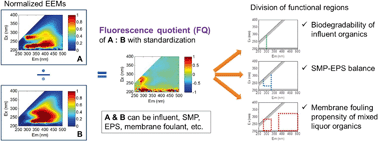当前位置:
X-MOL 学术
›
Environ. Sci.: Water Res. Technol.
›
论文详情
Our official English website, www.x-mol.net, welcomes your
feedback! (Note: you will need to create a separate account there.)
Fluorescence quotient of excitation–emission matrices as a potential indicator of organic matter behavior in membrane bioreactors†
Environmental Science: Water Research & Technology ( IF 3.5 ) Pub Date : 2017-11-29 00:00:00 , DOI: 10.1039/c7ew00270j Kang Xiao 1, 2, 3, 4, 5 , Shuai Liang 1, 2, 3, 4, 6 , Aihua Xiao 4, 6, 7, 8 , Ting Lei 4, 5, 9, 10, 11 , Jihua Tan 1, 2, 3, 4 , Xiaomao Wang 4, 5, 9, 10, 11 , Xia Huang 4, 5, 9, 10, 11
Environmental Science: Water Research & Technology ( IF 3.5 ) Pub Date : 2017-11-29 00:00:00 , DOI: 10.1039/c7ew00270j Kang Xiao 1, 2, 3, 4, 5 , Shuai Liang 1, 2, 3, 4, 6 , Aihua Xiao 4, 6, 7, 8 , Ting Lei 4, 5, 9, 10, 11 , Jihua Tan 1, 2, 3, 4 , Xiaomao Wang 4, 5, 9, 10, 11 , Xia Huang 4, 5, 9, 10, 11
Affiliation

|
The potential of using excitation–emission matrix (EEM) fluorescence spectroscopy in revealing organic matter properties has yet to be fully exploited. A fluorescence quotient (FQ) method was established to graphically compare different EEM spectra and hence, reflect the differential properties of organic matter in a wastewater treatment process on the basis of EEM. FQ is defined as a standardized element-wise quotient of two EEM spectra for organic matter in different states (e.g. before and after degradation) or in different forms (e.g. in sludge, in supernatant or on membranes as foulants). This method was applied to two full-scale membrane bioreactors, with multiple FQs calculated among the influent organics, sludge supernatant organics, extracellular polymeric substances and membrane foulants. Statistical analyses confirmed that the distribution of FQ as a function of the fluorescence excitation and emission wavelengths was significantly meaningful in highlighting the differential EEM characteristics, which enabled a clear depiction of the active regions of the different organics on an excitation–emission map. This might therefore indicate the differential propensity for a specific behavior of organic matter (such as biotransformation, sludge/water-phase distribution and membrane fouling) from the perspective of EEM. The FQ method provides a potential tool for EEM data exploitation to reflect organic matter behavior in wastewater treatment processes.
中文翻译:

激发-发射矩阵的荧光商作为膜生物反应器中有机物行为的潜在指标†
使用激发-发射矩阵(EEM)荧光光谱法揭示有机物特性的潜力尚未得到充分开发。建立了荧光商(FQ)方法,以图形方式比较了不同的EEM光谱,从而反映了基于EEM的废水处理过程中有机物的差异特性。FQ定义为两个EEM光谱的标准化元素商,用于两个不同状态(例如,降解之前和之后)或不同形式(例如,降解)的有机物在污泥,上清液或膜上作为污垢)。该方法应用于两个全尺寸膜生物反应器,在进水有机物,污泥上清液有机物,细胞外聚合物和膜污垢物之间计算出多个FQ。统计分析证实,FQ作为荧光激发和发射波长的函数的分布对于突出显示EEM的差异特性非常有意义,这可以在激发-发射图上清楚地描绘出不同有机物的活性区域。因此,从EEM的角度来看,这可能表明有机物特定行为(例如生物转化,污泥/水相分布和膜污染)的不同倾向。
更新日期:2017-11-29
中文翻译:

激发-发射矩阵的荧光商作为膜生物反应器中有机物行为的潜在指标†
使用激发-发射矩阵(EEM)荧光光谱法揭示有机物特性的潜力尚未得到充分开发。建立了荧光商(FQ)方法,以图形方式比较了不同的EEM光谱,从而反映了基于EEM的废水处理过程中有机物的差异特性。FQ定义为两个EEM光谱的标准化元素商,用于两个不同状态(例如,降解之前和之后)或不同形式(例如,降解)的有机物在污泥,上清液或膜上作为污垢)。该方法应用于两个全尺寸膜生物反应器,在进水有机物,污泥上清液有机物,细胞外聚合物和膜污垢物之间计算出多个FQ。统计分析证实,FQ作为荧光激发和发射波长的函数的分布对于突出显示EEM的差异特性非常有意义,这可以在激发-发射图上清楚地描绘出不同有机物的活性区域。因此,从EEM的角度来看,这可能表明有机物特定行为(例如生物转化,污泥/水相分布和膜污染)的不同倾向。











































 京公网安备 11010802027423号
京公网安备 11010802027423号